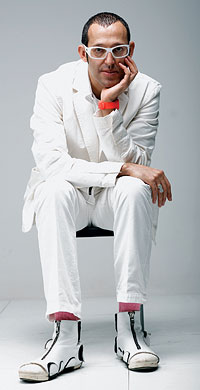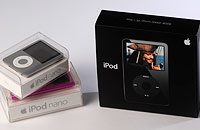The Shape of Things to Come
By Caperton Gillett
It is possible to avoid industrial design. This would involve running through the woods completely naked, but it can be done.
The point behind Erin Wright’s vivid image is that everything we touch—from the clothes we wear to the streets on which we drive—has been crafted with an eye toward functionality and, to varying extents, aesthetics.
 Erin Wright
Erin WrightIndustrial design is everywhere, and that’s why good and bad examples can have such a profound impact on daily life, says Wright, a graphic designer and chair of UAB’s Department of Art and Art History. “Really good design often goes unnoticed because it’s so effective,” he says, “but poor design is frustrating and causes people all kinds of consternation.”
Poorly designed products can be harmful to humans, harmful to the environment, and harmful to a company’s bottom line. The opposite is also true: In an era of unprecedented mass production and consumption, good design is not just a matter of taste—it can be the way for a product to stand out from the crowd.
Form Follows Function
Late-19th-century American architect Louis Sullivan declared it to be “law” that “form ever follows function,” a credo interpreted by many modernist architects as a condemnation of ornamentation and decorative elements.
This was hardly a new idea. Before the rise of mechanization in the late 18th century, everyday items were designed with more attention to utility than aesthetics. “When you were a pioneer out on the plains, your tools were purely functional,” Wright says. “They didn’t have to be beautiful. They just had to solve the problem.”
Then came the Industrial Revolution, which “ushered in a new approach to the manufacture of goods,” he says. “Here we are being able to create multiples of things—not only cheaply in cost but also cheaply in terms of the quality of the product.”
Faster and less expensive manufacturing meant that producers could afford to invest in more aesthetically pleasing designs, but not all of them did. The mass production of shoddy goods and the decline in work for skilled craftspeople resulted in a backlash. The Arts and Crafts movement in 19th-century England was a protest against the loss of hands-on production; it triggered the similar Craftsman movement in the United States.
Both movements brought about “a shift in the way we experienced art and design,” says Brett Levine, director of the UAB Visual Arts Gallery. Ironically, however, many of their distinctive shapes and profiles were the product of new technology for shaping metal and wood. Where once aesthetic attention had been limited to ornaments applied to a piece’s basic design, now the design itself could be aesthetically pleasing.
Most people don’t think of iconic Craftsman pieces such as Stickley furniture as being “designed,” says Levine. But the simplicity of the Craftsman movement, which emphasized simple, handcrafted furnishings in contrast to Victorian opulence and mass production, ultimately contributed to the Art Deco movement in the 1930s—one of the most revered design styles of the 20th century.
Form Finds a New Function
 Karim Rashid
Karim Rashid
Today, design is more often a corporate statement than a philosophical one. “I think design is, in a sense, the great differentiator between one company and another or one brand and another,” says Karim Rashid, UAB’s 2008 Pauline Ireland Visiting Artist, who is himself a prolific industrial designer. Rashid’s designs for Method cleaning products, which are sold by retailing giant Target, not only make them easier to use and more attractive to display but also help them stand out on the shelves, he says. And standing out from the crowd is an essential attribute in today’s teeming marketplace. “The minute we think globally, we have so much more competition,” Rashid says. “We’ve got to get up to speed or we’re out of the game.”
Iconic product, packaging, and logo designs have another function, says Levine. In addition to differentiating their products from competitors, designers also aim to associate them with other products within their own lines. Levine notes that this branding acts as a signal to consumers that an unfamiliar product can be safely associated with the quality and success of its older brothers and sisters.
One of the best examples of contemporary design is Apple’s iPod music player, says Levine. A customer who knows nothing about the new iPod nano is still led to assume that it will be just as good as the iPods that preceded it, all from one look at the shiny silver case or the Apple logo on the box.

What would appear to be an intuitive process—for instance, making one Nike product associable with others by slapping on the company’s iconic swoosh—is actually a vast and profitable industry. “Companies spend millions of dollars getting the logo and the coloring just right so people are more apt to buy their products,” says Tom DeCarlo, Ph.D., chair of the industrial distribution program in the School of Business. From the box a product comes in to the shape of the product itself, “logos, coloring, and the actual design of the packaging have been shown in research to really enhance or detract from people’s purchasing decisions.”
Design can affect the bottom line in other ways, as well. “One of the trends that we’re seeing in packaging is that it’s becoming more green,” DeCarlo says. “Wal-Mart has mandated that suppliers for certain toys reduce their packaging. Wal-Mart isn’t known for its great corporate reputation, but I think they’re leading the way in some of these environmental changes.” The discount chain saved $3.5 million in transportation costs in 2007 by trimming packaging, and those numbers have attracted the attention of other companies, DeCarlo says. “You’ll see much tighter packaging and less plastics and harmful environmental materials in the future.”
FORM AND FUNCTION SET UP SHOP
Manufacturing advances have also allowed companies to take the next step: outsourcing design decisions to their own customers. Nike’s iD shoes and T-Mobile’s Sidekick phone allow consumers an unprecedented amount of customization, from colors to basic features. Innovations in production and materials leave the door open for one-off designs that are customized for form, function, and ergonomics. One day, consumers may be able to purchase shoes with integrated custom orthotics or cell phones designed to fit a specific hand.
“If you’re six-foot-nine, all of a sudden you can have a broom with a longer handle,” Levine says. But he doesn’t think that this fiddling qualifies as true design. “We believe that by being able to customize the outside of something, we’re making it better,” he says. “We all want to be designers, but we don’t really know what that means. So we become decorators and use the word design.”
To Rashid, the future of industrial design is that there will be more of it. “Things are getting better in general,” he says. “A lot of these products that were really ill-considered are now being designed. The most banal things in our world, even a light switch, a door handle—everything is now taking on this idea of design.”